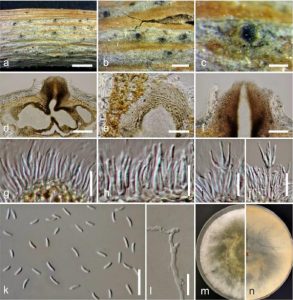Cytospora parakantschavelii Norphanphoun, Bulgakov, T.C. Wen & K.D. Hyde, sp. nov., Index Fungorum number: IF552607
Etymology: The specific epithet is composed from Greek prefix ‘para-’ meaning ‘near’ or ‘beside’ and ‘kantschavelii’ is from the species name, in reference to the occurrence on Cytospora species.
Holotype: MFLU 15-2094
Associated with twigs and branches of Populus × sibirica G.V. Krylov & G.V. Grig. ex A.K. Skvortsov [P. balsamifera L. × P. nigra L.] and Pyrus pyraster (L.) Burgsd. Sexual morph: Undetermined. Asexual morph: Conidiomata 750–900 × 750–850 μm diameter, semi-immersed in host tissue, solitary, scattered, erumpent, with 3–6 locules, with ostiolar neck. Ostioles 540–680 μm diameter, at the same level as the disc surface. Peridium comprising several layers of cells of textura angularis, with inner most layer thin, hyaline to brown, outer layer brown to dark brown. Conidiophores branched, reduced to conidiogenous cells. Conidiogenous cells blastic, enteroblastic, phialidic, hyaline, smooth-walled. Conidia (4.5–)5.3–5.7 ×1.1–1.3(–1.6) μm (x̅ = 5.3 × 1.4 μm, n = 30), unicellular, elongate-allantoid, hyaline, smooth-walled.
Culture characteristics: Colonies on MEA, reaching 8 cm diameter after 7 days at 25 °C, producing dense mycelium, margin rough, white, lacking aerial mycelium.
Material examined: RUSSIA, Rostov Region, Shakhty City, steppe slopes near Grushevsky pond, ravine shrubbery, on dead and dying branches of Pyrus pyraster (L.) Burgsd. [= P. communis auct.] (Rosaceae), 14 May 2015, T. Bulgakov (MFLU 15-2094, holotype, PDD isotype), ex-type living culture, MFLUCC 16-0575, KUMCC; RUSSIA, Rostov Region, Shakhty City, block landpark, on dying branches of Populus × sibirica G.V. Krylov & G.V. Grig. ex A.K. Skvortsov [P. balsamifera L. × P. nigra L.] (Salicaceae), 12 May 2015, T. Bulgakov (MFLU 15-1953, PDD), living culture, MFLUCC 15-0857, KUMCC.
Notes: The new species, Cytospora parakantschavelii (MFLUCC 16-0575, MFLUCC 15-0857) is similar to C. kantschavelii (287-2) in having multiloculate conidiomata. However, conidial dimensions of C. parakantschavelii (5.3 × 1.4 μm) are longer and wider than those of C. kantschavelii (4–5 × 1.2 μm) (Fig. 11) (Gvritishvili 1973).
Phylogenetic analysis of four combined gene loci place Cytospora parakantschavelii (MFLUCC 16-0575, MFLUCC 15-0857) on a separate branch from C. kantschavelii, forming as a sister taxon to C. salicicola Norphanphoun, Bulgakov & Hyde (MFLUCC 14-1052, MFLUCC 15-0866) (Fig. 2). However, C. salicicola differs from C. parakantschavelii in having shorter ostioles (170–200 μm), unbranched conidiophores and larger conidia (6.8 × 1.6 μm).
FIG: Cytospora parakantschavelii on Pyrus pyraster (L.) Burgsd. (MFLU 15-2094, holotype). a Stromatal habit in wood. b Fruiting bodies on substrate. c Surface of fruiting bodies. d Cross section of the stroma showing conidiomata. e Peridium. f Ostiolar neck. g–j Conidiogenous cells with attached conidia. k Mature conidia. l Germinating spore. m, n Colonies on MEA (m-from above, n-from below). Scale bars: a = 2000 μm, b = 500 μm, c, d = 200 μm, f = 100 μm, e = 50 μm, l = 20 μm, g–k = 10 μm.

